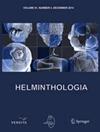Microscopic examination of internal parasites in Iraqi camels (Camelus dromedarius) with molecular focus on Trichostrongylus spp.
IF 1.2
4区 生物学
Q4 PARASITOLOGY
引用次数: 0
Abstract
Summary The camel has played a role in human civilization since its inception and holds significant importance in the customs and agricultural practices of various nations. This study examined the prevalence of internal parasitic infestations in camels within the Al-Diwaniyah and Al-Najaf provinces of Iraq from December 2021 to September 2022. A total of 200 fecal samples were randomly collected from farm camels, revealing that these animals were affected by one or more types of intestinal parasites.对伊拉克骆驼体内寄生虫进行显微镜检查,分子研究重点是三尖虫属(Trichostrongylus spp.
摘要 自人类文明诞生以来,骆驼一直在人类文明中扮演着重要角色,在各国的风俗习惯和农业生产中占有重要地位。本研究调查了 2021 年 12 月至 2022 年 9 月期间伊拉克迪瓦尼耶省和纳杰夫省骆驼体内寄生虫病的流行情况。研究人员从农场骆驼中随机采集了 200 份粪便样本,结果显示这些骆驼感染了一种或多种肠道寄生虫。线虫感染率最高,为 56%,其次是原生动物(28.5%)、绦虫(14.5%)和吸虫(1%)。在这些寄生虫中,三腔线虫所占比例最高,为 33%,其次是 Moneizia benedeni(12.5%)、Fasciola hepatica(10.5%)、Strongyloides spp.(8%)、Giardia spp.(7%)、Nematodirus spp.(6%)和 Eimeria spp.(6%)。此外,还观察到骆驼中的混合种或单一种感染,包括产气荚膜瘤(Anoplcephala perfoliata)(4 %)、血吸虫属(Haemonchus spp.)(3.5 %)、Dictyocaulus spp.(3 %)、毛滴虫(Trichuris trichura)(2.5 %)、恩塔米巴虫(Entamoeba spp.)(2 %)和大肠杆菌(Balantidium coli)(1 %)。此外,还采用了巢式聚合酶链式反应(PCR)来鉴定毛滴虫(Trichostrongylus spp.),45.4%的骆驼对这种寄生虫检测呈阳性。
本文章由计算机程序翻译,如有差异,请以英文原文为准。
求助全文
约1分钟内获得全文
求助全文
来源期刊

Helminthologia
生物-动物学
CiteScore
1.80
自引率
0.00%
发文量
21
审稿时长
>12 weeks
期刊介绍:
Helminthologia (HELMIN), published continuously since 1959, is the only journal in Europe that encompasses the individual and collaborative efforts of scientists working on a different topics of human, veterinary and plant helminthology. The journal responsibility is to enrich the theoretical and practical knowledge in very specific areas and thus contribute to the advancements in human and veterinary medicine and agronomy. Taking the advantage of comprehensive and multidisciplinary approaches journal still maintains its original spirit and is principal source of fresh scientific information regarding helminths, endoparasites and plant parasites. Addressing the most up-to date topics journal gained rightful and exceptional place next to the other high-quality scientific journals publishing in its field.
 求助内容:
求助内容: 应助结果提醒方式:
应助结果提醒方式:


